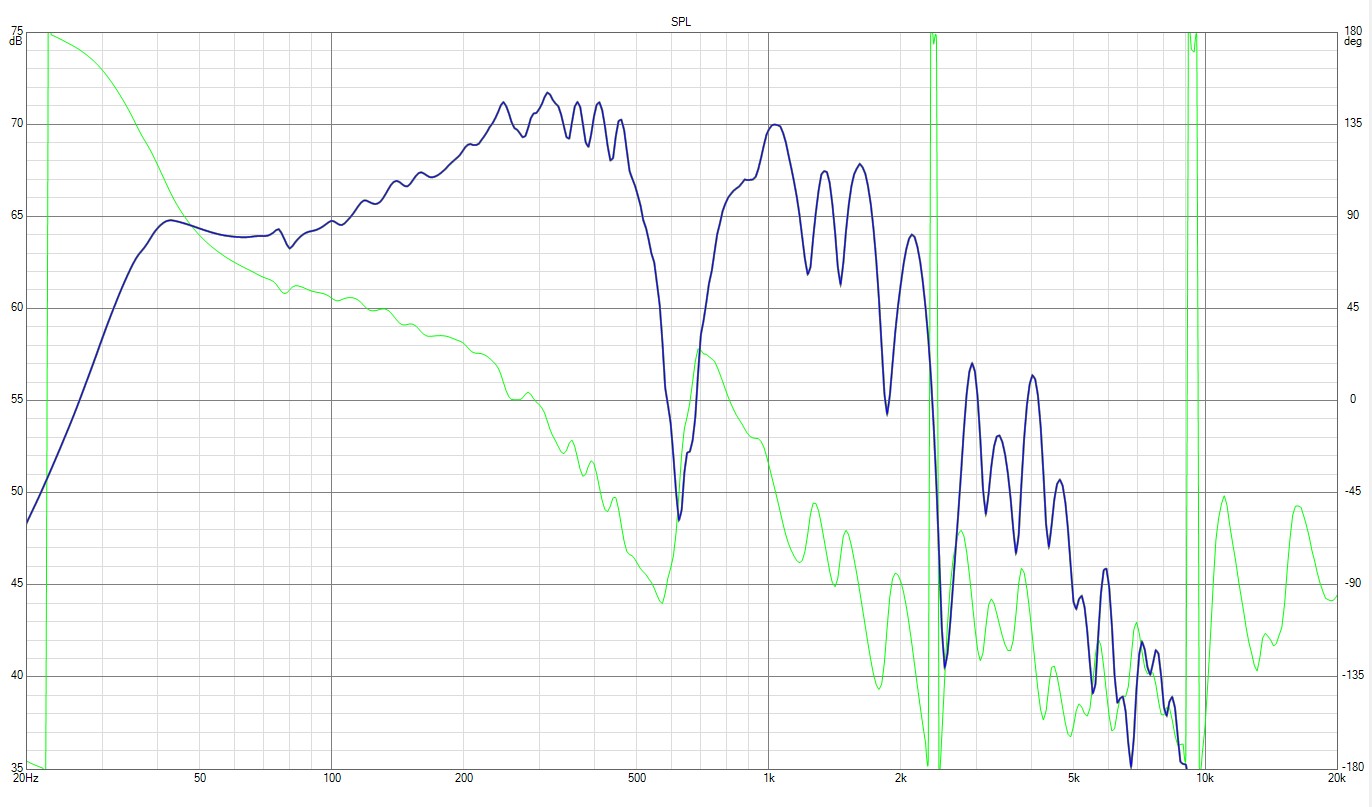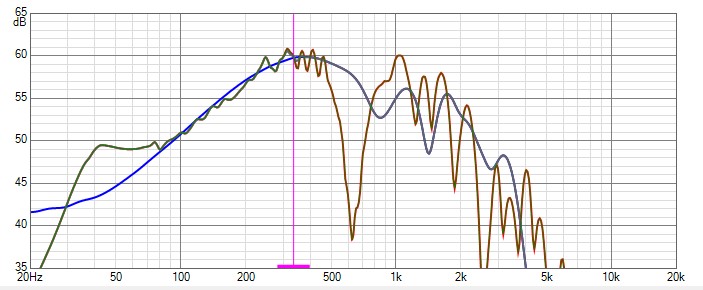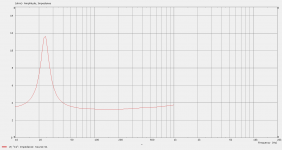You missing probably one step to get H-frame LF measurement. You need to add to measured near field response same response with phase inversion and delay. Delay in your case is 20 cm sound travel time.
Simulation result are like this. I take H-frame panel thickness 20 mm, SPP-250 T/S parameters are form Monacor page. Dipole peak and 40 Hz level difference is more than 20 dB, you get only 7 dB.
How i get to my H-Frame response:
Nearfield measurement link in the photo above showed this FR:

With Dipolcancallation (merged with inverted Phase and delay)

Merged with 1m Farfield-Measurement:

Delay is a little bit more then 20 cm.... Its (10^2+15^2)^1/2 + 10 cm = 28cm time travel. Thickness of the H-Panel is 19mm. The Sound source point is in the middle of the H-Profile but this means that front chamber is smaller (depth 5 cm) then the rear chamber (depth 13cm).
You missing probably one step to get H-frame LF measurement. You need to add to measured near field response same response with phase inversion and delay. Delay in your case is 20 cm sound travel time.
Simulation result are like this. I take H-frame panel thickness 20 mm, SPP-250 T/S parameters are form Monacor page. Dipole peak and 40 Hz level difference is more than 20 dB, you get only 7 dB.
Also is interesting to see speaker excursion data from simulation. It is taken with 2.83V input, you can calculate how big it will be if you will add +20dB EQ on 40 Hz.Value is in mm, m plus prefix m..
This is true, but in this regard the spp-250 is something special. There is no x-damage (at least at normal listening level), what i have read so far. The coico coil gets only out of his normal working range and will lead to more distortion. It has higher distortion at 30-40Hz. Therefore you get the small x-max.
One of the less known solutions could be the LF from the MoDiPo:
It looks to be unintentionally a hybrid of a nxt and a dipol. The simulation showed this bass-response:
Or:
But the measurement...:
Some links:
Modipo -Hörbericht von Bertramxxl - Seite 2
MoDiPo (vorgestellt in K+T 05/11) – Donhighend Audio
Basic question on OB
It would be very interesting to discuss this. How to intentionally achieve it with a dipole? We could take the modipo and look how the measurements differs if we change some parameters.
My idea is, that with the high qts the spp-250 works like a exciter near the resonance frequency. Especially 3 of them could make a additionally bass boost. Take a look at this study:
https://www.google.com/url?sa=t&source=web&rct=j&url=http://orca.cf.ac.uk/56177/&ved=2ahUKEwjnybCL3pzvAhVLyaQKHQU7A-kQFjAAegQIARAC&usg=AOvVaw2z7M-MlocFrYL3zXvuEGOJ
Go Hybrid😎
What do you say to this response? There was some explanations about it. With an accelaration meter it was measured a movement from the Chamber at LF, This gived a addational subboost. I took the same Wood with the same Driver and tried to stimulate this effect. Interestingly the Chamber works with the driver like a resonance-system at 25 Hz. But it works in dipol-pattern...
Strange that the difference with simulation is so big, specially peak at 40 Hz. General rule is that all OB speakers had to lower frequency direction form dipole peak 6 db/octave slope.
I know Akabak can be not very accurate in higher than 1000Hz, but in bass region it must be correct. I had made some simulation and tests measurements on prototypes in 200-2000 Hz range and they are very close.
I know Akabak can be not very accurate in higher than 1000Hz, but in bass region it must be correct. I had made some simulation and tests measurements on prototypes in 200-2000 Hz range and they are very close.
This is not very reasonable, H-frame cavity resonances are much higher for this size H-frame. With 2 12" speakers in narrow, 60 cm deep H-frame they are at about 200 Hz, in your H-frame they are about 3 times higher, but Q of resonance is low. Nxt pinciple cannot be present here, frame is too heavy and moving coils are connected to speaker cones, not to frame/cabinet.What do you say to this response? There was some explanations about it. With an accelaration meter it was measured a movement from the Chamber at LF, This gived a addational subboost. I took the same Wood with the same Driver and tried to stimulate this effect. Interestingly the Chamber works with the driver like a resonance-system at 25 Hz. But it works in dipol-pattern...
Last edited:
Had you measured impedance of H-frame speaker?
If there is something special on 40 Hz, it must be visible somehow.
I generated impedance of simulation, there is nothing special on 40 Hz.
If 40 Hz peak is caused by Qts 0.90, then it must be visible also in simulation.
If there is something special on 40 Hz, it must be visible somehow.
I generated impedance of simulation, there is nothing special on 40 Hz.
If 40 Hz peak is caused by Qts 0.90, then it must be visible also in simulation.
Attachments
This is not very reasonable, H-frame cavity resonances are much higher for this size H-frame. With 2 12" speakers in narrow, 60 cm deep H-frame they are at about 200 Hz, in your H-frame they are about 3 times higher, but Q of resonance is low. Nxt pinciple cannot be present here, frame is too heavy and moving coils are connected to speaker cones, not to frame/cabinet.
My H-Frame has 2 SPP250 with 10" is 20 cm deep. If you look here at Page 28, the Dipolpeak at 400-500 Hz is normal.
The peak at 40Hz is something special, Yes. This is more or less the same, as what happend with this speaker:
3-Way OB - get the best out
I used the same driver with the same wood to stimulate this Peak at 30Hz. This speaker with measurements came out in a german paper for loudspeaker design. In the web you can find the explanation, from the people who measured the enclosure with a accerlation meter, that the Peak at 30-40Hz comes from the enclosure. It reacts like a resonance-system. This was not a goal but a very nice have...
My personal explantion is the following: At resonance frequency a driver beginns to vibrate. If its a high qts driver the vibration at resonance frequency are not damped enough. This vibration will be forewarded to the enclosure, so that under some circumstances (wood type etc) the enclosure will make sound (there are different types of sound, that can come frome the enclosure like nxt and other observation.
I think this would be a nice explore...😎
But my measurements are in this manner the same like with the MoDiPo-Bass section...
Best regard,
Tomas
My H-Frame has 2 SPP250 with 10" is 20 cm deep. If you look here at Page 28, the Dipolpeak at 400-500 Hz is normal.
I forgot this link: http://www.dipolplus.de/downloads/Dipol_Schallwand.pdf
Here is how i add the invert signal of the LF-Dipol.
db = 0
delay: 882 uS for ~30cm
So this is near to your akabak. But has only a rise of 6 db at 40Hz. More or Less the same effect like on the MoDiPo.
db = 0
delay: 882 uS for ~30cm
An externally hosted image should be here but it was not working when we last tested it.
So this is near to your akabak. But has only a rise of 6 db at 40Hz. More or Less the same effect like on the MoDiPo.
Last edited:
I used the same driver with the same wood to stimulate this Peak at 30Hz. This speaker with measurements came out in a german paper for loudspeaker design. In the web you can find the explanation, from the people who measured the enclosure with a accerlation meter, that the Peak at 30-40Hz comes from the enclosure. It reacts like a resonance-system. This was not a goal but a very nice have...
My personal explantion is the following: At resonance frequency a driver beginns to vibrate. If its a high qts driver the vibration at resonance frequency are not damped enough. This vibration will be forewarded to the enclosure, so that under some circumstances (wood type etc) the enclosure will make sound (there are different types of sound, that can come frome the enclosure like nxt and other observation.
This is very strange.
I not see any reasonable explanation for the 40 Hz peak.
But more strange is that this is repeatable 40 Hz peak in different builds.
NXT principle cannot cause this peak.
Do you know how many times bigger is the mass of enclosure compared to speaker cone mass? About same times less will be the sensitivity of NXT radiator with enclosure mass if speaker coli is connected directly to enclosure wood. In real life H-frame build coil is connected to speaker cones and between cones and cabinet wood is suspension and speaker frame what together damps oscillation and very few of energy is transferred to enclosure.
As enclosure is open H-frame and sound energy is freely radiated from speaker cone, energy from cones are nearly not at all transferred to the enclosure with sound radiation.
Also if there is some force what make speaker enclosure vibrating, to the sound radiation of the enclosure applies also dipole cancellation law. That mean to lower frequency direction form dipole peak, sensitivity is falling with 6 dB/octave slope. Dipole peak frequency for enclosure radiation cannot be less than it is for speakers inside enclosure.
Can you measured impedance curve of your H-frame speaker?
Hi kaameliis,
i took again a better look on the measurements of the MoDiPo. I think their biggest boost is at 20Hz with these effect (the room was to small for so an effect). In their explanation the reason was really the enclosure. They said the enclosure with the speaker worked like a resonance-system. But yes, overall till 20 Hz with dipol pattern.
That was the reason i first wanted to realize a 3-Way Dipole with the Bass-Section of the MoDiPo. But WAF was stronger....😀
I have a smaller enclosure, therefore a higher resonancefrequency. In my enclosure i have 19mm MDF probably 60cm*70cm per side. But not only the overall amount of wood is important. I took a little bit of research in this field. The tension of the wood, the enclosure design, and the driver, how many driver you use, ect... is important. I made, some test with OSB-Wood, too. But, Mdf had a stonger effect.
How to measure the impadance?
i took again a better look on the measurements of the MoDiPo. I think their biggest boost is at 20Hz with these effect (the room was to small for so an effect). In their explanation the reason was really the enclosure. They said the enclosure with the speaker worked like a resonance-system. But yes, overall till 20 Hz with dipol pattern.
That was the reason i first wanted to realize a 3-Way Dipole with the Bass-Section of the MoDiPo. But WAF was stronger....😀
I have a smaller enclosure, therefore a higher resonancefrequency. In my enclosure i have 19mm MDF probably 60cm*70cm per side. But not only the overall amount of wood is important. I took a little bit of research in this field. The tension of the wood, the enclosure design, and the driver, how many driver you use, ect... is important. I made, some test with OSB-Wood, too. But, Mdf had a stonger effect.
How to measure the impadance?
Probably i go to open a new thread ant to share some of my findings and studies.
Because get the best out from 3 way is so far finished...
Additionally i will go to open a seperate topic with different XO on my dipoldesign. And other tweaking ideas....
Because get the best out from 3 way is so far finished...
Additionally i will go to open a seperate topic with different XO on my dipoldesign. And other tweaking ideas....
Impedance can be measured with REW: Impedance Measurement
If sound card had no headphone output, then also external amplifier can be used but then need to be care not to burn sound card input with over voltage, some voltage dividers are needed.
Had you any direct link where MoDiPo case resonance is explained or described? I had difficulties to search with German language, but I can use Google translate if you can point link to correct page.
If sound card had no headphone output, then also external amplifier can be used but then need to be care not to burn sound card input with over voltage, some voltage dividers are needed.
Had you any direct link where MoDiPo case resonance is explained or described? I had difficulties to search with German language, but I can use Google translate if you can point link to correct page.
MoDiPo (vorgestellt in K+T 05/11) – Donhighend Audio
But nothing about resonance there..
Klang&Ton MoDiPo als Subwoofer, Lautsprecher - HIFI-FORUM
Bingo! Basic question on OB
post by Rudolf Finke: The Modipo panel happened to develop a sort of NXT behaviour down to 20 Hz - unintentionally. That made it a real attention getter wherever it was presented. Sheer luck.
But nothing about resonance there..
Klang&Ton MoDiPo als Subwoofer, Lautsprecher - HIFI-FORUM
Bingo! Basic question on OB
post by Rudolf Finke: The Modipo panel happened to develop a sort of NXT behaviour down to 20 Hz - unintentionally. That made it a real attention getter wherever it was presented. Sheer luck.
Impedance can be measured with REW: Impedance Measurement
If sound card had no headphone output, then also external amplifier can be used but then need to be care not to burn sound card input with over voltage, some voltage dividers are needed.
Had you any direct link where MoDiPo case resonance is explained or described? I had difficulties to search with German language, but I can use Google translate if you can point link to correct page.
Franky in this forum wrote this:
"Habe gerade mal den Beschleunigungsaufnehmer an die Oberkante der Schallwand geklebt.
Fabian hat recht! Die Schallwand schwingt deutlich sichtbar um mehrere Millimeter bei nur 2,83V mit und wirkt somit als Gesamtlautsprecher oder besser gesagt als Resonanzsystem. (durchaus von der Wirkung her vergleichbar einem extrem tief abgestimmten Bassreflexsystem)"
The LinkModipo -Hörbericht von Bertramxxl - Seite 2
Juhazi, you read my doubt why NXT behavior cannot be present with MoDiPo case to cause low frequency peak?
Can be Rudolf just was incorrect?
Can be Rudolf just was incorrect?
Impedance can be measured with REW: Impedance Measurement
If sound card had no headphone output, then also external amplifier can be used but then need to be care not to burn sound card input with over voltage, some voltage dividers are needed.
Had you any direct link where MoDiPo case resonance is explained or described? I had difficulties to search with German language, but I can use Google translate if you can point link to correct page.
MoDiPo (vorgestellt in K+T 05/11) – Donhighend Audio
But nothing about resonance there..
Klang&Ton MoDiPo als Subwoofer, Lautsprecher - HIFI-FORUM
Bingo! Basic question on OB
post by Rudolf Finke: The Modipo panel happened to develop a sort of NXT behaviour down to 20 Hz - unintentionally. That made it a real attention getter wherever it was presented. Sheer luck.
Impedance can be measured with REW: Impedance Measurement
If sound card had no headphone output, then also external amplifier can be used but then need to be care not to burn sound card input with over voltage, some voltage dividers are needed.
Had you any direct link where MoDiPo case resonance is explained or described? I had difficulties to search with German language, but I can use Google translate if you can point link to correct page.
Franky in this forum wrote this:
"Habe gerade mal den Beschleunigungsaufnehmer an die Oberkante der Schallwand geklebt.
Fabian hat recht! Die Schallwand schwingt deutlich sichtbar um mehrere Millimeter bei nur 2,83V mit und wirkt somit als Gesamtlautsprecher oder besser gesagt als Resonanzsystem. (durchaus von der Wirkung her vergleichbar einem extrem tief abgestimmten Bassreflexsystem)"
The Link: https://www.diy-hifi-forum.eu/forum/showthread.php?3870-Modipo-H%F6rbericht-von-Bertramxxl/page2
Juhazi, you read my doubt why NXT behavior cannot be present with MoDiPo case to cause low frequency peak?
Can be Rudolf just was incorrect?
IIts not really classical NXT. I found a paper, who describes the effect. At least i think so:
https://www.google.com/url?sa=t&source=web&rct=j&url=http://orca.cf.ac.uk/56177/&ved=2ahUKEwjnybCL3pzvAhVLyaQKHQU7A-kQFjAAegQIARAC&usg=AOvVaw2z7M-MlocFrYL3zXvuEGOJ
On what page it is described?IIts not really classical NXT. I found a paper, who describes the effect. At least i think so:
https://www.google.com/url?sa=t&source=web&rct=j&url=http://orca.cf.ac.uk/56177/&ved=2ahUKEwjnybCL3pzvAhVLyaQKHQU7A-kQFjAAegQIARAC&usg=AOvVaw2z7M-MlocFrYL3zXvuEGOJ
"Habe gerade mal den Beschleunigungsaufnehmer an die Oberkante der Schallwand geklebt.
Fabian hat recht! Die Schallwand schwingt deutlich sichtbar um mehrere Millimeter bei nur 2,83V mit und wirkt somit als Gesamtlautsprecher oder besser gesagt als Resonanzsystem. (durchaus von der Wirkung her vergleichbar einem extrem tief abgestimmten Bassreflexsystem)"
The Link: Modipo -Hörbericht von Bertramxxl - Seite 2
I read also this, but Google missed probably some details.
Do you know why I not see measurement images on page 3 of this topic, are they missing or I need to have account?
- Home
- Loudspeakers
- Multi-Way
- 3-Way OB - get the best out
